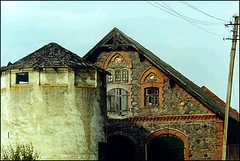


I am curious about the concept of "junipers." I thought this referred to the plant/bush, but the first image I have posted is called "Colored Junipers." Is it a lost-in-translation term? Or is the shape simply abstracted in the painting?
"One of the most influential artists of the Moscow forbidden art was the Estonian Ülo Sooster (1924–1970). He belonged among those numerous people deported to Siberia from Estonia in 1950, and who had suffered the horrors of a prison camp. After his release in 1956 and marriage, he stayed in Moscow where he found a common language with many independent Russian artists, including Ilya Kabakov. The latter wrote a monograph about Sooster, considering him one of his mentors. The manuscript had to wait years during the Soviet period before it was finally published in 1996 by the publishing house Kunst in Estonian, Russian and English — Kabakov had managed to emigrate from Russia in the meantime and rise to the echelons of the New York art scene. An obituary of Sooster, incidentally, appeared in the last issue of ‘Vitvarne Umeni’ (1970), a liberal Czech art magazine before it was closed after the Prague spring events.
Ülo Sooster’s art grew out of the tradition of Picasso and surrealism. Essentially, however, he found an outlet in art to express the inequality in society, accepting no compromises himself. ‘No compromises’ primarily meant refusing to co-operate with the communist party. His visions circled around three geometrically abstracted images — an egg, juniper and fish. Like the 20th century avant-garde artists, Sooster was tremendously fascinated with the triumph of science, drawing and painting weird ‘scientific’ visions."
-from ESTONICA.com
He died in 1970 at the tender age of 46, after years of drug and alcohol abuse, but apparently he remains a figurehead in the history of Estonian modern art.
“It seems that not only Sooster’s art but his entire personality has become an integral part of a powerful mythology, which still remains so vividly in the minds of the people who were touched by his presence.” (pg. 48. Eda Sepp, Estonian Non-Conformist Art from the Soviet Occupation in 1944 to Perestroika.)








No comments:
Post a Comment